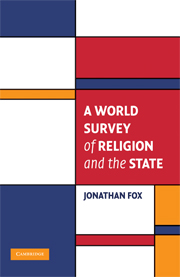Book contents
- Frontmatter
- Contents
- Acknowledgments
- 1 Introduction
- 2 The Question of Religion's Role in Politics and Society Modernization, Secularization, and Beyond?
- 3 Quantifying Religion
- 4 Global GIR from 1990 to 2002
- 5 Western Democracies
- 6 The Former Soviet Bloc
- 7 Asia
- 8 The Middle East and North Africa
- 9 Sub-Saharan Africa
- 10 Latin America
- 11 Patterns and Trends
- 12 Conclusions
- Appendix: Data Collection and Reliability
- Bibliography
- Index
6 - The Former Soviet Bloc
Published online by Cambridge University Press: 05 June 2012
- Frontmatter
- Contents
- Acknowledgments
- 1 Introduction
- 2 The Question of Religion's Role in Politics and Society Modernization, Secularization, and Beyond?
- 3 Quantifying Religion
- 4 Global GIR from 1990 to 2002
- 5 Western Democracies
- 6 The Former Soviet Bloc
- 7 Asia
- 8 The Middle East and North Africa
- 9 Sub-Saharan Africa
- 10 Latin America
- 11 Patterns and Trends
- 12 Conclusions
- Appendix: Data Collection and Reliability
- Bibliography
- Index
Summary
During the communist era, the entire Soviet bloc was consistently antireligious. Since 1990 religion has returned with a vengeance including a considerable amount of state support for religion. Yet this pattern of support is different from that in Western democracies. While there are few, if any, instances of government support due to historical inertia, history has had a considerable impact on the current relationship between religion and state in the region.
The states in the region tend to have a paternalistic attitude toward religion in that they tend to feel a need to guide and protect their citizens with regard to religion. They accomplish this through regulating and controlling citizens' access to religion. Three interrelated manifestations of this phenomenon are particularly conspicuous. First, in all but one state religions must register. Second, the majority religion in these countries tends to be subjected to relatively heavy regulation. Third, religions seen as dangerous or nonindigenous to the state are often restricted. All of these trends are discussed here in more detail.
Despite these similarities, there is considerable diversity in the nature and extent of government involvement in religion (GIR) in the region. The information presented in Tables 6.1, 6.2, 6.3, and 6.4 makes it exceedingly clear that former Soviet bloc governments have become significantly involved in religious issues. Of the 27 governments examined here, only 1 has an official religion.
- Type
- Chapter
- Information
- A World Survey of Religion and the State , pp. 140 - 180Publisher: Cambridge University PressPrint publication year: 2008

